The Portland Bureau of Transportation released a major update to their Outer Souther Division Multimodal Safety Project today. And as we hinted at back in November, the latest plans (now at 60 percent design) have added more auto parking and have loosened turning restrictions for drivers.
PBOT has also shared new before/after visuals to give us a better sense of what’s in store for this project.
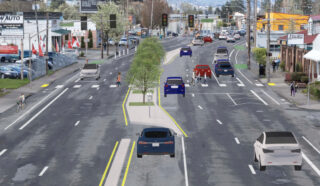
In what has become a standard tool for PBOT’s communications team, the slick new “story map” lays out the reasons for the project. Top among them is safety:
“If you lined up all the cars that have been crashed on outer Division in the past five years,” the website reads, “they’d stretch from Portland City Hall to downtown Gresham. Division is one of the most dangerous corridors in the city for all modes, ranking #1 for total motor vehicle crashes, #2 for total bicycle crashes, and #1 for pedestrian serious injuries and deaths… On Division between SE 80th and SE 174th, nearly 1,000 people are involved in crashes every year (driving, walking, and/or biking). That’s almost three people every day whose lives are changed as a result of this dangerous street.”
To help cure this sick street, PBOT will add: 4.7 miles of bike lanes separated from other road users via a combination of plastic delineator wands and paint-only buffer strips; 13 new signalized crossings; 57 new street lights, 1.15 miles of concrete median islands, and add three miles of sidewalks. Those changes will complement two measures they’ve already completed: a lower speed limit (from 35 to 30 mph) and the presence of six speed reader boards and two speed cameras.
Advertisement
In the year or so since they first presented their plans to people who live, work and use Division Street, PBOT has been hearing feedback about how best to balance the need to protect human lives with the need for people to be able to conveniently use cars. Today PBOT has confirmed the following modifications to the design:
● The preliminary plans showed no on-street parking throughout the project area. The final plans bring back pockets of on-street parking where the design allows (space is created on one side of the street where U-turns occur).
● Working directly with businesses on Division [through the Division Midway Alliance], we have incorporated a few places where the medians will allow left turns in from Division while still restricting left turns out. In these special cases, business operations were determined to be severely impacted by the medians because the size of vehicles would not have been able to make use of the provided U-turn areas.
● Based on community feedback and further site analysis, traffic engineers determined that a full traffic signal at 125th would be warranted to facilitate safe turns and crossings.
Construction of this project is expected to start in early next year and be completed by the end of 2019. Learn more on the project website.
— Jonathan Maus: (503) 706-8804, @jonathan_maus on Twitter and jonathan@bikeportland.org
Never miss a story. Sign-up for the daily BP Headlines email.
BikePortland needs your support.



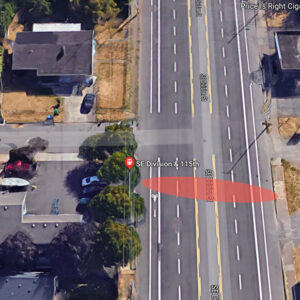
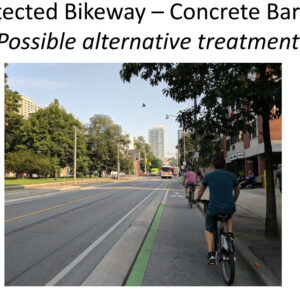
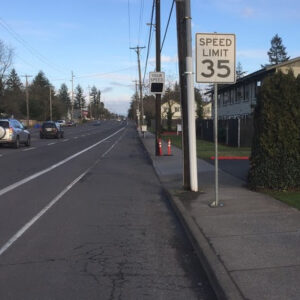
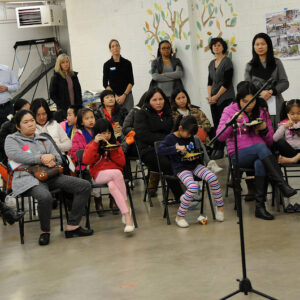
Thanks for reading.
BikePortland has served this community with independent community journalism since 2005. We rely on subscriptions from readers like you to survive. Your financial support is vital in keeping this valuable resource alive and well.
Please subscribe today to strengthen and expand our work.
I find it absolutely pathetic and negligent that PBOT is willing to lay down concrete for tree lined medians but refuses to curb protect the bike lane on a street like this. Leah Treat put out the mandate that all designs start with protection. Plastic wands are NOT protection. Perhaps more than any project I’ve seen, this one is a clear indicator that PBOT is not 100% committed to Vision Zero. If there’s ever a project that needed real physical separation from cars, this is it.
Normally I would agree with you on this, but Division is in the unusual position that there will be a separate transit project constructed only a few years after these improvements. The scope of that project will include concrete curbs and floating bus islands. What they’re doing here is claiming the space and getting something on the ground quickly (by PBOT standards) and doing it in a way that doesn’t preclude further improvements funded by Trimet.
Division BRT may be next year, it may be 10 years later, it might be never.
Meanwhile people are dying and getting high-impact injuries. We need to do something now.
DH,
cyclists are dying on outer Division?
Why don’t you check the PBOT vision zero crash map?
If this is true, it may make more sense for PBOT to explicitly claim “interim” projects and “capital” projects such as the NYC DOT does. For example, Queens Blvd and 4th avenue in Brooklyn will have similar implementation of plastic bollards and an interim phase. Several years later when more money is available and plans are ironed out, the DOT builds the final capital project. As a result people in NY know the initial project may not be perfect, but provides a sort of interim phase to both allow minimal physical separation, and promise trees and concrete separation in the next 5 year or so.
PBOT appears often to provide a one-off that may or may not be a the final say on a street for a decade regardless of how “finished” it appears.
And I find the trees as another obstacle to being able to see all user of the road, even those that we know will want to continue to cross the streets wherever they deem fit. I have called the city plenty of times about the crosswalks that have trees and tall bushes in them as they do not promote visibility. All users need the extra reaction time and we don’t get it when they want to add “brush.”
But to add to your statement, sometimes you can’t get the Rolex but the Casio ain’t bad. Visible markers are better than nothing. Want Vision Zero to be taken seriously? Add enforcement.
If there is going to be on street parking that “protects” bike lanes by reducing visibility the spots need to be metered at a bare minimum. Delineator posts are definitely an improvement on most designs coming out of PBOT right now but the presence of intermittent parking that reduces the ability for bicyclists and drivers to be aware of each other and anticipate conflict is asking for this dangerous stretch of road to remain in that state, just with a new design.
The space for parking spots would also be better utilized for bus stops. Speaking of buses, the conflict built into this design between bikes and buses could easily be designed away if that were one of the goals. Incremental improvements are the best we can evidently hope for right now.
I just love how the street is defined as dangerous. Take the motor vehicles off it and is there any risk of death or serious injury? No? Well, then the danger is not the street but the drivers’ behavior on the street.
The additional 53 light poles will go a long way for all users. Lack of enforcement and PBOT’s neglect has been a big contributor to the mess that is Division.
If you want to be reductionist about it, the real problem is that we have developed no better point-to-point transportation system, and require people to travel by car to move with any level of time-efficiency around the city.
People’s behaviors are a response to the situation they’re in. To change the behavior, we need to change the situation.
Have we really not developed more effective systems for transportation inside cities than cars? In pretty much every cross-city contest, cars come in last after bicycles and transit. They also eat up much more space per mile traveled than bicycles or transit, space that could be more effectively used for housing and business.
We clearly haven’t found anything better, otherwise everyone would be using that.
I believe that automated cars should be considered a new mode, and, by removing some of the negatives aspects of the current generation of cars, they will completely supplant the current generation of transit as well as manually driven cars. I see this as inevitable; the only thing I think is debatable is the time horizon over which that will happen.
Also, even in a parallel universe where 80% of people relied on TriMet, we would not be tearing up our streets to make more room for housing or business. That aspect of our urban fabric is pretty much fixed, at least for the next 100 years.
“We clearly haven’t found anything better, otherwise everyone would be using that.”
Is this how it works? Darwinism in the realm of transport? The best always wins?
For that to be true wouldn’t the playing field have to be leveler? Wouldn’t we need to tax fuel according to its full social and enironmental costs? Wouldn’t we have had to resist the urge – as a matter of policy – to quash, displace, pave over, ticket all other, prior modes, alternative ways of getting around?
Several folks here routinely espouse this idea that the reason we have cars is that they are in Dr. Pangloss’ fashion the best possible solution, that they simply are better at X or Y or Z. I think the reality is just a bit more complicated; the history more tortuous.
It depends on how you measure “best”. Most people measure it by how well it works for them, and cars are clearly dominant mode.
I don’t think I’ve ever said anything to suggest I think they are the best possible solution to any problem. Only that, for many people in many situations, they are better than the available alternatives.
You are privileging the individual perspective here.
When we are talking feet or bikes, mode choice scales well; there are few if any externalities;* the individual and collective experience don’t markedly diverge. But with the auto, things scale terribly. Each additional car on the road makes everything worse, slower, more dangerous, and expensive. The car, which when defined narrowly and from the driver’s perspective, offers all manner of perks, clearly isn’t even in the running when scaled up. I don’t think (in 2018) it is still tenable to filter these other dimensions out of the comparison. And insisting on doing so does work, is not an innocent mistake.
*we even recognize some returns to scale such as the idea that as more and more people bike it becomes safer for everyone.
I wonder how well cars would work for people at $12 a gallon, with indirect routes that have lots of stop signs and beg buttons, with parking priced at market value without government subsidy or payroll deductions, and with human-friendly speed limits on all roads where pedestrians are present.
@9watts
Most good policies manage to incentivize the individual perspective in such a way that it also benefits the population.
“Wouldn’t we need to tax fuel according to its full social and enironmental costs?”
Now what progressive is going to let that happen to someone who is poor?
“Most good policies manage to incentivize the individual perspective in such a way that it also benefits the population.”
I’m not sure what that means. Can you explain? Give an example?
“Now what progressive is going to let that [taxing fuel to fully reflect costs] happen to someone who is poor?”
This is the jeering from the sidelines you gravitate to here. How about contributing constructively? There are of course tradeoffs between the objectives of Pigovian taxation and the regressive potential within a society as unequal as ours, but your approach predictably obfuscates any of these distinctions, makes fun of positions without offering anything, taking a stand, engaging.
Dan A: If things were different, then things might be different. I will note that plenty of people drive in Europe and Japan, where gas prices are much higher than they are here.
9watts: I’m not “privileging” any perspective, only offering an explanation for what I have observed.
Do you acknowledge the divergence btw private and public, individual and collective perspectives on the question of how the auto meets our needs?
Of course. But since most people make decisions based on their personal perspectives, those are most relevant to explaining their behavior.
“Now what progressive is going to let that happen to someone who is poor?”
There are ways to credit the poor to remove your argument, if we want to go that route.
We already know gas is WAY too cheap. Anytime I see someone sitting in their truck for minutes at a time with the engine running, it’s obvious.
“But since most people make decisions based on their personal perspectives, those are most relevant to explaining their behavior”
Maybe I stumbled into the wrong party, but I thought we here were able and inclined to look beyond the edge of our own plate, to recognize the limitations of the perspective you are reifying here.
If we don’t, why even bother having a conversation? Doing so runs the risk of learning something new.
“We here” are not making the vast bulk of the decisions about how to get from place to place. And even most people in this forum make daily decisions from a personal perspective. Remember, we’re talking out using observations of how people get around to reveal which mode offers the greatest benefit to people.
For something to be dangerous, humans have to be there. If peds and cyclists don’t go there, they are also at no risk for injury or death.
The basic problem is this is an urban highway. Many people cannot afford Portland’s totally insane housing prices, and the only thing that will put downward pressure on that is to make it possible for people to work and live further away.
The improvements are welcome. Removing parking and the center lane should lead to a much more predictable traffic flow — which I think will be faster, but safer nonetheless.
You are simply incorrect. If peds and cyclists disappeared from the roadway tomorrow, we’d still have roadway deaths and serious injuries aplenty. In fact, most deaths and serious injuries on our roadways involve people who are inside cars.
We have multiple modes in use on our streets. Only one of them routinely creates deaths and serious injuries, and it doesn’t discriminate among its victims based on their mode.
And the point would be what, that we should convert one of the few major auto routes into the city for transit and active transport only?
Few people are willing to travel more than trivial distances using active transport, and when weather isn’t ideal, they’re not even willing to do that. The much hyped Better Naito is virtually empty even in summer at rush if it’s raining as it was last Friday Even if outer Division had awesome separated infrastructure, it’s hardly like that it would be busy with peds and cyclists.
Even if transit can help, it’s only a piece of the puzzle. Division could be made into a transit corridor, but that wouldn’t change the fact that people still have to get to and from that corridor, deal with whatever/whoever they’re responsible for, etc. There’s a reason why so many people find sitting on 26 and 84 a superior alternative to MAX which zooms by.
Transportation is ultimately about getting people around. So even if questions should be raised when people are getting hurt and killed, it does not follow that people should be prevented from doing the activity.
For all the talk about how unsafe the roads are, your lifetime chances of getting killed on them are roughly 1%. Which means that your lifetime odds of getting killed by something else are 99%. There’s more to life than just being safe on the roads. https://www.iii.org/fact-statistic/facts-statistics-mortality-risk
Dang, it sounds like we need better funding to reduce these automobile deaths!
**sentence deleted by moderator**. There CAN be such a thing as a poorly designed road which has a negative impact on safety. Take the same vehicles driving on SE Division and plop them on a NW street, and the drivers won’t be as dangerous there because the NW streets are better designed. The NW streets are safer for drivers, pedestrians and cyclists. Road design matters…lanes, crosswalks, medians, speed limit, traffic lights, etc. SE Division has been neglected and is overdue for an improvement.
BC,
Quite literally, yes, there would still be risk, but it would be small.
Long overdue….since annexation in 1988-1991. The Division Casio Bikeway, as Doug Hecker very appropriately terms it. Catchy.
David Hampsten, since you are somewhat of a historian of the area, did the city agree to rebuild the streets when they annexed E Portland? I know they agreed to provide water and sewer services, which they largely did.
The current problems with the street network in E Portland are primarily a reflection of the conditions present when the city annexed the area. To my knowledge, there has not been wholesale reconstruction of the street network in any part of town since that time.
The water was already being supplied, but you are right, the point touted of the 1986-1991 annexation was to put in home sewers wherever they didn’t currently exist, but of course the city made all kinds of promises to justify their (still illegal) annexation, promises that they might have been able to afford had not there been such a steep and profound statewide property tax reduction in 1992 which nearly bankrupted the city.
The county built nearly all the present roads and storm sewers. 102nd/Cherry Blossom in the late 90s and SE 136th more recently were the only major streets that PBOT rebuilt. The Blue Line MAX and I-205 were built during the annexation process by other agencies while TriMet, Halliburton and ODOT built the Green and Red MAX lines. PBOT has authorized several cul-de-sacs and no-outlet developments since annexation built by developers, so clearly PBOT has contributed their part to the mess that is East Portland.
The recent surge in new sidewalks and bike infrastructure for East Portland started in 2010 under Mayor Sam Adams. Most of the new sidewalks are from 2012 (I had a big hand in that.)
Why was the annexation illegal?
This is a good start. There’s no good reason for Division to be so wide, or so fast, east of 82nd. I live nearby and cross Division at 87th twice a day on my bike. It’s dangerous because drivers treat it like a speedway, I can’t even trust them to stop at the crosswalks all the time.
I’d love to live in a more walkable neighborhood, but as soon as you go east of 82nd you enter the Land that PBOT Forgot. This will help the area tremendously.
I like the mixed concrete and tree medians. Trees have been proven to encourage car drivers to slow down and the side gutters can’t support tree roots, while the concrete medians will make jaywalking safer in an area where most people crossing jaywalk, as it is too dangerous to cross at intersections. The bikeways seem to be well-designed with a mix of wands and buffer paint, though I do agree that a Jersey barrier here and there would be better; a curbed lane would be ideal, but they are so expensive.
I do confess that I’m worried about planting trees right over the Division Street aqueduct. Or has the fresh water line been moved? Then again, I suppose the trees should thrive right there.
DH,
Please provide a citation we can review for proof that trees slow people driving. There are plenty of tree lined streets in Portland with speeding cars on them.
Is your second sentence meant as satire?
When did Portland start adding in tree lines on streets?
actually, if Foster is any canary, you won’t see these changes for at least another 4 years.
If Southwest was the canary, we wouldn’t see any of this in at least 50 years after annexation, so by 2041. I share your skepticism about the timeline.
Oh gee, another Powell Blvd. This is what they did to Powell when the MT Hood freeway died and they had this wide property with no freeway to build. They created huge planting strips with trees and a center median with trees. They took out any existing auto parking, replacing them with useless mini-lots to fill the space they didn’t use for the freeway. Now the trees are overgrown and block visibility. Business users on the North side are always parking on the sidewalk or planting strip and obstructing visibility. There’s still 2 lanes of traffic each way so cars are always speeding. At least the mini-lots give the houseless somewhere to park.
Is Powell Blvd a street you’d call safe? No, it’s not. And I don’t see how the new Division will be any more appealing to cyclists or any less appealing to drivers.
The pedestrians will at least get a break with all the new signalized crossings. Unfortunately they disabled and then removed all the signals at the crossings along Powell. I’m sure ODOT didn’t like all those drivers being slowed down.
PBOT just doesn’t have the strength to do what is needed on these streets and seriously curtail motor vehicle use. There’s an entire extra lane that drivers don’t need that they can give over to mass transit.
Instead of putting a median with trees that makes it so peds have to cross 2 streets they could put in a planting strip and trees along the sidewalk to give shade to peds instead of drivers.
PBOT won’t get out of their car.
Powell has no bike lanes.
Are you sure?
https://www.google.com/maps/@45.496377,-122.5505719,3a,75y,88.49h,81.13t/data=!3m6!1e1!3m4!1sa613b045G5EBJt7daois5w!2e0!7i13312!8i6656
And if it had bike lanes it still wouldn’t be pleasant to cycle along and would be less pleasant to walk across.
powell has some of the best stretches of de facto bike lane in east portland…the actual bike lane acts as a 5 foot buffer to the “bike lane” that most people use.
Outer Powell does have bike lanes, has for over 15 years, east of I-205. However, unlike inner Powell, it lacks most sidewalks.
I consider those “bike-walk lanes. ODOT was to cheap to make proper sidewalks.
Of course, as most of you knew anyway, the OP and I were both referring to inner-Powell (west of 92nd).
Take it easy on Leah–she had many “courageous conversations.”
I honestly can’t imagine that the elite planners of this naive design have spent much time in East County beyond the obligatory focus groups and minority outreach sessions. They fail to grasp the basic understanding of what is going on out on outer division st. The sad truth is of the matter is that people are driving like jerks on purpose, not by accident or that they didn’t know the rules of the road or that they didn’t have enough lights or paint.
What we are talking about here is a willful disregard for the safe operation of automobiles, which, though increasingly common throughout all quarters of our city, is most prevalent in the wide open spaces outside the core.
We are living in a new age, one where the automobile, once a symbol of freedom and independence has become a weaponized phallus engorged with rage, a mobile terrorism device and menace to life beyond itself.
Bring on the Jersey barriers, tire teeth and retractable bollards protecting bike boulevards, impervious to lift kits, loud pipes and ragers with relationship issues.
Comment of the week.
I’ve observed that people driving better now than they did decades ago. I’m not saying people drive well or safely, just that driving culture has generally improved somewhat.
Kind of a generalization, no? People?
Not being able to count on driver attention seems like a big one to me.
Distraction didn’t start with cell phones, of course, but it has demonstrably gotten worse – I think we’d all agree. And the problems we had before cell phones, have they improved by enough to more than offset the phone effect? Last time I checked on the statistics chances for those not in cars were worse than ten years ago.
https://patch.com/oregon/across-or/pedestrian-deaths-oregon-increase-despite-safety-efforts
“From 2016 to 2017, pedestrian deaths increased a little more than 20 percent across the state.”
“Pedestrians now account for roughly 16 percent of all motor vehicle deaths, the group said. That number was 11 percent just a few years ago.”
Of course it’s a generalization. And yes, generally, distraction has been getting worse.
Distraction AND impatience.
I think a lot of progressives are willing to support higher fuel taxes, despite their regressiveness, especially if the funds raised are used to fund improvements in providing more lower-income people with alternatives to driving.
Driving is a choice, so fuel taxes can only be considered regressive in the same way that cigarette taxes are regressive. You have to think globally. Climate change disproportionately affects the global poor, so we are hurting the poor by not taxing fuel.